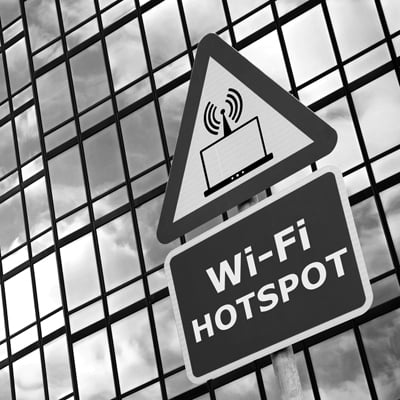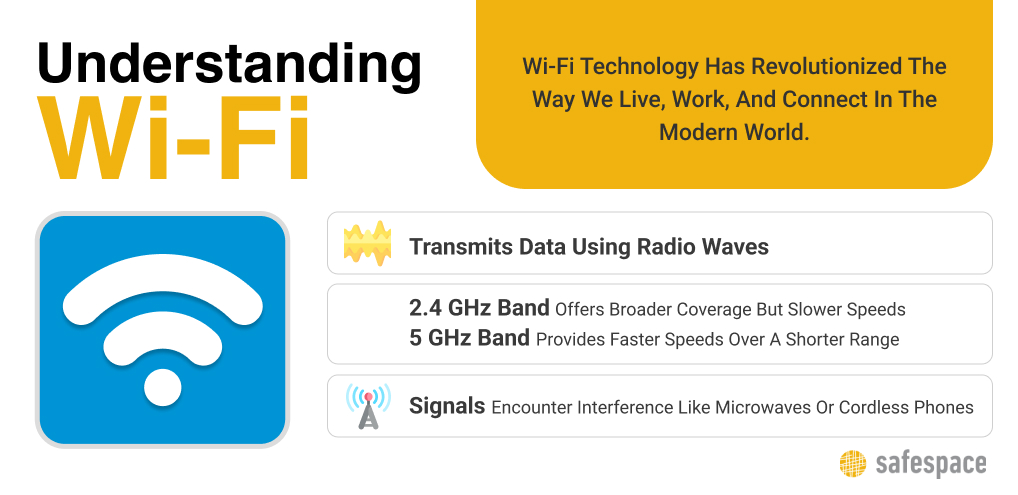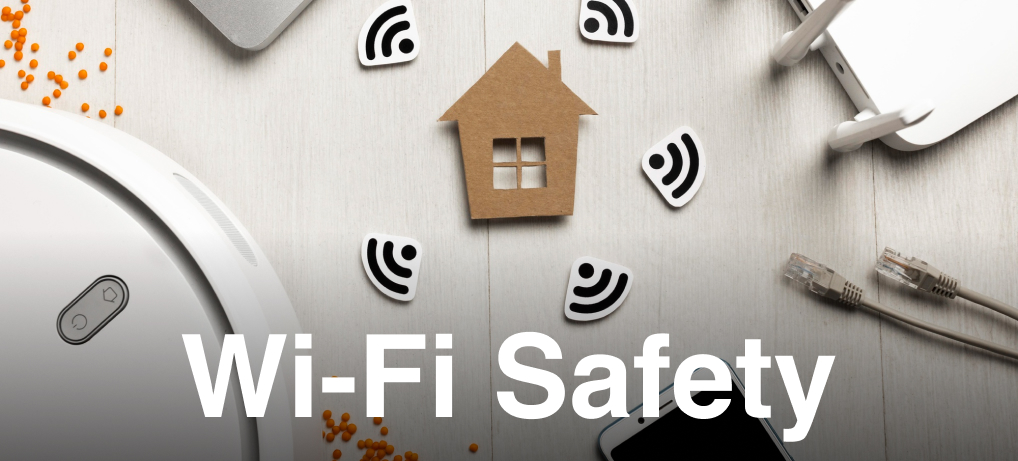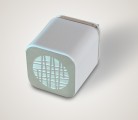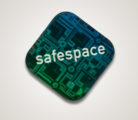Is Wi-Fi Dangerous?
Here’s What You Need to Know
Is Wi-Fi dangerous? In today's connected world, it's a pressing concern for many. The short answer is that current scientific research has not shown significant health risks associated with Wi-Fi radiation. But to fully grasp this topic, we have to dig deeper into the science.
In this guide, we’ll address myths and misconceptions and explain how to safely manage your Wi-Fi use.
Understanding Wi-Fi and Its Prevalence
Wi-Fi technology has revolutionized the way we live, work, and connect in the modern world. It has become a fundamental part of daily life, from streaming movies and browsing the web to managing smart home devices.
But What Exactly Is Wi-Fi?
Wi-Fi, short for Wireless Fidelity, is a technology that enables devices like smartphones, laptops, and tablets to connect to the internet or communicate with each other wirelessly. Using radio waves, Wi-Fi transmits data over the air, allowing us to stream movies, browse the web, and stay connected to the digital world without cables.
How Wi-Fi Has Become an Essential Part of Modern Life
Wi-Fi has become a cornerstone of modern living in today's digital age. It connects us at home, work, coffee shops, and public transport, making it easier than ever to access information and stay in touch. The proliferation of smart home devices, from thermostats to voice assistants, relies heavily on Wi-Fi, emphasizing its integral role in our daily routines.
How Wi-Fi Works
Wi-Fi uses radio frequencies, specifically the 2.4 GHz and 5 GHz bands.
- Signal Transmission: A Wi-Fi router emits radio waves, which carry information between connected devices and the internet.
- Bandwidth Allocation: The 2.4 GHz band offers broader coverage but slower speeds, while the 5 GHz band provides faster speeds over a shorter range. This dual-band approach allows users to choose the band that suits their needs.
- Channel Interference: Wi-Fi signals can encounter interference from other devices, like microwaves or cordless phones, which operate on similar frequencies. Modern routers mitigate this by selecting the optimal channel automatically.
Comparison with Other Wireless Communication Technologies
Wi-Fi isn't the only wireless technology, but it stands out for its unique attributes.
- Cellular Networks: While cellular networks provide broader coverage, they often come with data caps and slower speeds compared to Wi-Fi.
- Bluetooth: Bluetooth operates at 2.4 GHz but is designed for short-range connections, making it ideal for connecting peripherals like headphones or keyboards.
- Zigbee and Z-Wave: These technologies are primarily used for smart home devices, offering low-power, long-range connections but at slower speeds compared to Wi-Fi.
Common Concerns About Wi-Fi Safety
Wi-Fi has become a part of modern life, but its ubiquitous presence has raised concerns about its potential health risks. One topic is the electromagnetic radiation emitted by Wi-Fi routers and how it compares to other sources such as cell phones and microwaves.
Electromagnetic Radiation and Health
The radiation emitted by Wi-Fi routers is non-ionizing, meaning it lacks the energy to ionize molecules or break chemical bonds. This places Wi-Fi radiation on the lower end of the electromagnetic spectrum, distinct from higher-energy radiation like X-rays and gamma rays. This non-ionizing nature sets Wi-Fi apart from potentially harmful forms of radiation.
When comparing Wi-Fi radiation to other Wi-Fi-emitting devices, we see that Wi-Fi radiation is considerably lower in power than the EMFS emitted by a mobile phone, which is often kept close to our bodies. Similarly, while microwaves operate at a similar 2.4 GHz frequency, their higher power levels and shielding create a stark contrast to the lower-intensity emissions from Wi-Fi routers.
Scientific Studies and Their Findings
Scientific studies exploring the potential health impacts of Wi-Fi radiation have been conducted on both animals and humans. Research on rats and mice has shown no conclusive evidence of significant health risks. Human studies, including longitudinal research involving large populations, have similarly found no consistent links between Wi-Fi exposure and major health issues.
This aligns with the consensus from major health organizations such as the World Health Organization (WHO) and the Food and Drug Administration (FDA). The WHO has stated that current evidence indicates no significant health risks associated with Wi-Fi radiation, and the FDA has also reviewed the available research, concluding that Wi-Fi exposure does not pose substantial health concerns.
Myths and Misconceptions
Now it’s time to talk about some misconceptions and debunk some myths.
Wi-Fi and Cancer
Concerns about a potential link between Wi-Fi and cancer have gained traction, fueled by fears that electromagnetic radiation could lead to DNA damage or cell mutations. However, current research does not support the existence of adverse health effects on the human body.
The non-ionizing nature of Wi-Fi radiation means it lacks the energy to break chemical bonds or alter DNA structures, setting it apart from higher-energy ionizing radiation. Studies investigating the relationship between Wi-Fi radiation and cancer have found no consistent evidence to support this connection. Major health organizations, including the World Health Organization and the Food and Drug Administration, have reviewed these studies and concluded that Wi-Fi radiation does not pose a significant cancer risk.
Wi-Fi and Other Health Issues
Beyond cancer, some individuals have raised concerns about Wi-Fi's impact on sleep, headaches, and fertility:
- Sleep Disturbances: Research into Wi-Fi exposure and sleep patterns has been inconclusive. While some individuals report sleep disturbances, no clear causal link between Wi-Fi radiation and disrupted sleep has been established in scientific studies.
- Headaches: Claims of Wi-Fi-related headaches have also circulated, yet current research does not indicate a direct correlation between Wi-Fi exposure and headaches. It's important to consider other environmental factors that could contribute to such symptoms.
- Fertility: Studies exploring the impact of Wi-Fi radiation on fertility have yielded mixed results. While some animal studies suggest potential reproductive effects, human studies have not demonstrated consistent evidence of Wi-Fi radiation affecting fertility
How to Mitigate Wi-Fi Exposure
While scientific research indicates that Wi-Fi radiation could pose minimal health risks, implementing practical steps to reduce exposure can offer additional peace of mind. One way to mitigate exposure is by positioning routers in less frequented areas, such as hallways or storage spaces. This reduces direct exposure to Wi-Fi signals during daily activities.
Another effective measure is to set Wi-Fi routers on timers, turning them off during the night or when not in use. This reduces overall exposure and can contribute to a healthier environment. For a more comprehensive solution, encouraging wired connections, such as Ethernet cables, can decrease reliance on Wi-Fi for devices like desktop computers and gaming consoles.
To further protect homes and offices, the EMF Adapter offers an all-in-one solution that sends a corrective signal through a building's electrical circuitry, neutralizing harmful EMF radiation throughout the entire space. It offers non-ionizing radiation protection to keep you safe from the electromagnetic fields caused by mobile phones and other wi-fi equipment. Additionally, the Radiant Room device is designed to protect individual rooms up to 400 square feet from electromagnetic fields, providing a portable solution for spaces like bedrooms, small offices, or hotel rooms, protecting overall human health that could be affected by long-term exposure.
Parents and families can take specific measures to manage Wi-Fi exposure. One key approach is managing children's screen time and encouraging offline activities to reduce reliance on digital devices. This not only minimizes Wi-Fi exposure but also promotes healthier habits.
Creating Wi-Fi-free zones in the home, such as bedrooms or dining areas, can further limit exposure and foster family bonding. Encouraging offline activities in these zones helps strike a balance between digital and offline life, contributing to a healthier and more connected family environment.
Balancing Connectivity and Health
Wi-Fi has undeniably shaped the way we live and work, connecting us in ways unimaginable just a few decades ago. While scientific research has found minimal health risks associated with its use, taking steps to manage exposure can offer additional peace of mind. By embracing both technological solutions and practical measures, we can enjoy the benefits of connectivity while maintaining a balanced, healthy lifestyle.
Know Your EMF Health Risks
- Cell and Smart Phones
- Electrostress from Computers
- EMFs in the Home
- Electrostress and Travel
- How to Protect Yourself in the Age of 5G Side Effects
- Power Lines
- Cell Towers
- Radiation from the Earth
- EMFs from Underground Pipes
- Smart Meters
- 5G Dangers & Health Effects: What You Need to Know
Choose Products to Protect Yourself

SafeSpace Solutions designed to counter the harmful EMF pollution from Wi-Fi routers
EMF Adapter
An all-in-one solution for clearing and protecting an entire home or office space from the harmful effects of EMF radiation. The EMF Adapter works through a building’s electrical circuitry Read more
Smart Patch
Our laboratory-tested SafeSpace Smart Patch has been proven to transform and neutralize the harmful effects of EMFs. When placed directly on devices it radiates a powerful protective field Read more


